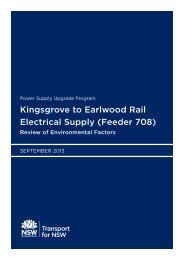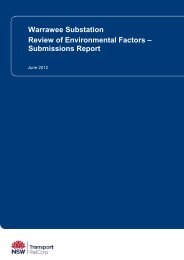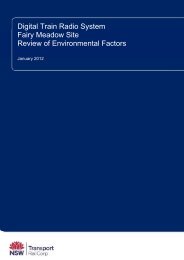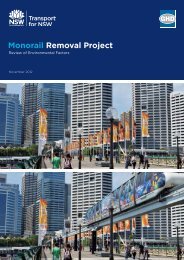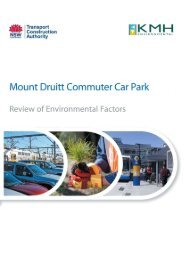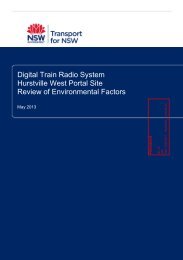Warrawee Substation - Review of Environmental Factors
Warrawee Substation - Review of Environmental Factors
Warrawee Substation - Review of Environmental Factors
- No tags were found...
You also want an ePaper? Increase the reach of your titles
YUMPU automatically turns print PDFs into web optimized ePapers that Google loves.
<strong>Warrawee</strong> <strong>Substation</strong> Page 6Operational Noise & Construction Noise & Vibration AssessmentReport No. 11332 Version B3 AMBIENT NOISE MONOITORINGBackground noise monitoring was conducted to determine the existing noise levels at theclosest residences in the vicinity <strong>of</strong> the site. Long term unattended monitoring was conductedwithin the rail corridor at the boundary <strong>of</strong> the closest residence (40 Brentwood Avenue). Thelocation is shown in Figure 2-1. This was supplemented by short-term attended measurementsat the residences on the other side <strong>of</strong> the rail corridor in Winton Street.3.1 Background Noise LevelsThe noise monitoring equipment used for the unattended measurements consisted <strong>of</strong> an ARLNGARA Type 1 environmental noise logger; logging both A-weighted and C-weighted noiselevels at fast response. This equipment is capable <strong>of</strong> remotely monitoring and storing one-tenthsecond noise levels and also records audio files for later detailed analysis. 15-minuteA-weighted noise level descriptors were determined through post-analysis <strong>of</strong> the NGARA data.The equipment calibration was checked before and after the survey and no significant driftoccurred.The logger determines L A1 , L A10 , L A90 and L Aeq levels <strong>of</strong> the ambient noise. The L A1 , L A10 and L A90levels are the levels exceeded for 1%, 10% and 90% <strong>of</strong> the sample time respectively (seeGlossary <strong>of</strong> Acoustic Terms for definitions). The L A1 is indicative <strong>of</strong> maximum noise levels dueto individual noise events such as the occasional passby <strong>of</strong> a heavy vehicle. The L A90 level isused to derive the Rated Background Level (RBL) which is used to determine many noisecriteria. The L Aeq level is the Equivalent Continuous Sound Level and has the same soundenergy over the sampling period as the actual noise environment with its fluctuating soundlevels. The L Aeq is used for the assessment <strong>of</strong> operational rail noise and traffic noise.Unattended monitoring was conducted between 6 January 2012 and 13 January 2012. Detailedresults are shown graphically in Appendix A. The graphs show measured values <strong>of</strong> L Aeq , L A90 ,L A10 and L A1 for each 15-minute monitoring period. The Rating Background Level (RBL) is asummary measure <strong>of</strong> the background noise level, and is defined in the OEH’s Industrial NoisePolicy ( INP ).Table 3-2 provides a summary <strong>of</strong> the noise levels for the daytime, evening and night timeperiods as defined in the NSW Office <strong>of</strong> Environment and Heritage Construction Noise Guideline(CNG). The summary values are:L Aeq,(period) – the equivalent continuous L Aeq noise level measured over the assessment period;andRBL – Rating Background Level is a measure <strong>of</strong> typical background noise levels which is used indetermining noise criteria.Attended measurements were conducted on 6 January 2012 using a Bruel and Kjaer Type 2260Sound Level Meter. These attended measurements were conducted to determine the differencein the background noise levels and the traffic noise levels between Brentwood Avenue andWinton Street and also to understand the contribution from traffic noise to the backgroundnoise levels.



